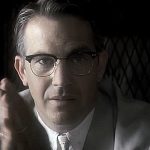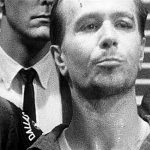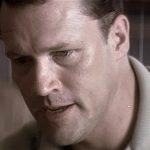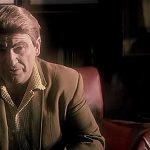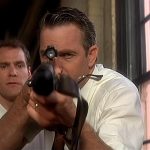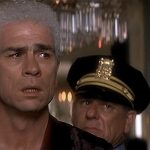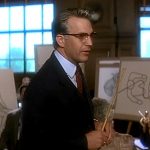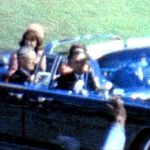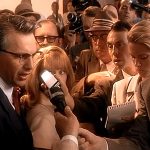
JFK – 1991
This was a good movie, but not, I think, for the reasons it was supposed to be. Obviously, it is a film that is centered around one of the most tragic events in American history, the assassination of John Fitzgerald Kennedy, the 35th President of the United States. Most of this movie was supposed to be about the investigation that took place 3 years after the murder, carried out by Jim Garrison, the New Orleans District Attorney. And it was. But that story almost seemed like a subplot next to the facts concerning the assassination.
What I mean is that the structure of the movie was too much like a documentary. It was almost 3 and a half hours long, and the most dramatic and interesting parts of the movie were about the event itself and not Jim Garrison’s investigation of it. And the scenes that were devoted to the investigation had some poorly written dialogue, a slow pace, and a bloated sense of self-importance. It was as if Garrison’s story was used as nothing more than a vehicle for the film makers to show the viewing audiences the amazingly suspicious facts surrounding JFK’s death.
That being said, there were some good performances. Kevin Costner played Jim Garrison, the man in charge who is obsessed with the investigation. His Assistants, Michael Rooker, Laurie Metcalf, and Wayne Knight as Bill Broussard, Susie Cox, and Numa Bertel. Sissy Spacek played Jim’s wife, Liz. Gary Oldman did a wonderful job playing the part of Lee Harvey Oswald. Tommy Lee Jones played Clay Shaw, the main conspirator being investigated in the trial. Joe Pesci, Kevin Bacon, Ed Asner, Jack Lemon, Walter Matthau, Donald Southerland, John Candy, Vincent D’Onofrio, and Jay O. Sanders all had supporting roles. So it had a pretty big list of Hollywood stars.
Everybody played their parts well enough, except for Joe Pesci. He is a good actor, but he started off one way, and ended up becoming his foul mouthed character from the movie Goodfellas. I don’t know if this was intentional, or if he just forgot to keep the southern drawl we heard him speaking with in his first scene.
But the real star of the film was the assassination, which took place in 1963. Director Oliver Stone did a pretty good job of mixing new footage shot for the film and real news footage from 1963 and 1966. But it was the money shot that stole the show – the Zapruder Film. That is the famous footage that clearly showed Kennedy’s head exploding. You see, I found the explanation of the facts surrounding the assassination fascinating. The film took a pretty solid stance, stating that Oswald could not have been the killer. It looked at the story that the government had given the public and picked it apart in amazing detail. It examined the event from every possible angle, interviewed eye-witnesses whose stories all told of shots coming from behind a fence, and put together re-creations. All this was shown within the context of Jim Garrison’s investigation and court trial, in which he tried to prove Clay Shaw’s involvement in the assassination.
The most crucial piece of evidence to support Garrison’s case about the assassination being a conspiracy was the magic bullet. The argument was made that in order for Kennedy to get wounded in the way in which he did from a single shooter such as Oswald, as well as taking into account the wounds of Texas Governor John Connally, the second bullet would have had to defy the laws of physics by doing things like pausing in mid-air and changing directions. Thus there had to have been more than one shooter, which implies a conspiracy. The film was based on two conspiracy theory books: On the Trail of the Assassins by the real Jim Garrison, and Crossfire: The Plot that Killed Kennedy by Jim Mars. The film seems to believe everything the books had to say.
Incidentally, if you do any research into the subject, you’ll find that modern computer enhanced investigations have been made, and there are those who can proove how the magic bullet could actually have made all the wounds while flying in a straight line. The magic bullet theory is only impossible if Connally was seated directly in front of Kennedy, facing forward. But the Zapruder film clearly shows him turned half way around to look at Kennedy as he is grabbing at his throat. This makes the lone gunman story seem very plausible. But putting the magic bullet aside, there were too many other suspicious events surrounding the murder. Was there a government conspiracy to assassinate Kennedy, or did Oswald act alone? I’m not sure if anyone really knows. But I personally believe there was. Too many of the people involved died or disappeared to perpetuate the cover-up.
Anyway, Costner’s impassioned speech to the jury in his closing argument was moving. And throughout the movie the common theme kept being reiterated. Why on earth should we sit still and mindlessly believe a government that would lie to us? That kind of government is not worthy of our trust or our loyalty. And if we have to fight to get an honest government, then it is our duty to do so. Actually, I found it a little heavy-handed, but that made it no less true.
